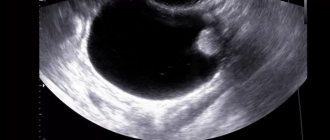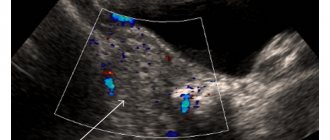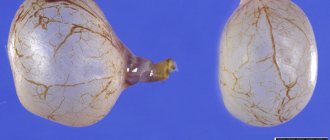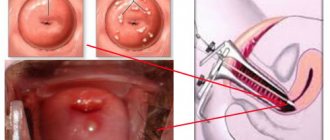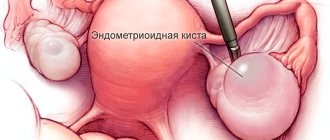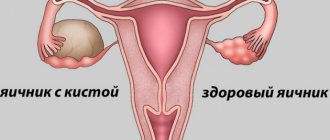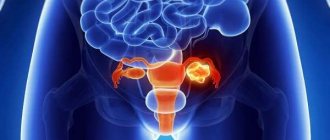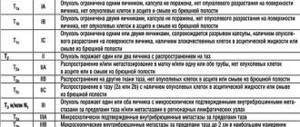In women, cavities filled with fluid may form on the surface or inside the ovary. Is it necessary to remove a cyst after detection, and can a cyst be dangerous to women's health? This largely depends on the reasons for the development of education, as well as on its structure and localization. The final decision on how to get rid of an ovarian cyst is made by the doctor after a series of diagnostic measures.
In this article we will talk about what features the removal of an ovarian cyst has and what methods are used to perform the operation.
Recovery period
After laparoscopy of ovarian cysts, the postoperative period for each patient proceeds differently. If the operation to remove an ovarian cyst went well, and the woman has an accompanying person, then she can leave the hospital premises a couple of hours after the operation, when the anesthesia wears off. But doctors strongly recommend staying in the hospital for the first day, since the girl needs specialist supervision during this time.
If laparoscopy of an endometrioid ovarian cyst was performed under general anesthesia, the patient will sleep for a couple of hours after it is completed. During this period, she may experience chills. This is how the body reacts to anesthesia. Only the doctor can know how long the operation lasts. He decides how long it will take him to completely remove the ovarian cyst.
The woman will feel the pain of an ovarian cyst after surgery as the effect of anesthesia wears off. The presence of pain should not alarm you, since the integrity of the tissues is compromised during laparoscopic surgery. These sensations disappear after injection of an anesthetic. The feeling of nausea and its manifestation in the form of vomiting can also be eliminated with medications prescribed by your doctor.
During the first day of the postoperative period after laparoscopy of an ovarian cyst, the woman experiences discomfort in the throat, which is explained by the presence of an anesthesia tube in it earlier. But this feeling quickly passes. You are allowed to get out of bed after six hours. The duration of being on your feet should not exceed an hour; a woman should limit herself to going to the toilet.
We recommend you learn: How to make your ovaries work to get pregnant
Laparoscopy of ovarian cyst - everything you need to know about the procedure
A surgical procedure such as laparoscopy of an ovarian cyst forms the basis of radical therapy. The operation is performed according to certain indications. When planning, the size of the formation, its structure, and structure are taken into account. Let's take a closer look at this method of treatment and name the main stages of the operation and recovery period.
Ovarian cyst - surgery or laparoscopy?
This kind of choice of method of surgical intervention is made by doctors. Many factors are taken into account. The main one is the size of education. If it is small (8-10 cm in diameter), laparoscopic surgery is performed to remove the ovarian cyst. This method involves minimal tissue trauma and does not require layered dissection of the abdominal wall. The necessary instruments are inserted through a small hole - 5 mm in diameter. The laparoscopy of the ovarian cyst itself (the progress of the operation) is recorded using video equipment, which reduces the risk of damage to surrounding organs.
When determining the method of surgical intervention, the indications for laparoscopy are taken into account, including:
The operation is not performed if:
- inflammation of the peritoneum;
- sepsis;
- cerebrovascular accident;
- myocardial infarction;
- hemorrhagic shock.
Preparation for laparoscopy of ovarian cyst
The period preceding surgery is associated with numerous diagnostic examinations. Thus, preparation for surgery to remove an ovarian cyst includes:
- blood tests: biochemistry, general, coagulability, determination of the Rh factor, infections (hepatitis, syphilis, HIV);
- Ultrasound of the pelvis;
- vaginal smears;
- ECG;
- fluorography.
These tests for ovarian cyst laparoscopy are an integral part of the preparation process. Their list can be expanded in the presence of chronic diseases. In order to cleanse the intestines the day before, the woman is prescribed a laxative and given an enema several hours before the start. 12 hours before laparoscopy of an ovarian cyst is performed, exclude food intake - the stomach should be empty. A woman’s psychological preparation plays a significant role. The day before, the doctor examines the patient, tells her the features of the operation, setting her up for a positive outcome.
How is surgery to remove an ovarian cyst performed?
When answering a patient’s question about how the operation to remove an ovarian cyst is performed, the doctor first draws attention to the fact that everything is done using a video camera. It is equipped with lenses that magnify the image displayed on the monitor many times over. The removal procedure itself takes place under general anesthesia; the woman does not feel anything.
Previously, punctures are made on the marked area, where the laparoscope is inserted. Then carbon dioxide is supplied. It is necessary for better access to the ovaries and straightening of the peritoneal cavity. A total of 3 cuts are made: in one there is a camera, the other 2 are for tools. Based on the image, the surgeon performs resection of the tumor. After laparoscopy of the ovarian cyst, gas is released from the abdominal cavity, stitches are placed on the punctures and they are covered with sterile bandages. The duration of the operation can be up to 3 hours, on average - 60 minutes.
Laparoscopy of ovarian cyst - postoperative period
Recovery after laparoscopy of an ovarian cyst is fast. In the evening after the operation the girl is allowed to get up. On the 3-4th day, the pain in the suture areas completely disappears. They are removed on 7-9 days. Until this point, daily treatment with an antiseptic is carried out, and an antibacterial ointment (Levomekol) is applied to the surface, which prevents infection.
After undergoing laparoscopy, doctors recommend adhering to the following rules:
- exclusion of strong physical activity for 1-2 months;
- abstaining from sex for 2 weeks;
- exclude visits to baths, saunas, replace hygienic baths with showers.
Diet after laparoscopy of ovarian cyst
Doctors urgently require adherence to a certain diet and careful attention to the composition of the diet. Immediately after laparoscopy of an ovarian cyst, 4-5 hours later, you are allowed to drink a small amount of still water. After 6-8 hours, the first meal is served - liquid broth. During the first 24 hours, it is allowed to consume fermented milk products - kefir, yogurt.
On day 2, pureed vegetable soup is introduced into the diet. The second dish can be a steamed cutlet, zucchini or mashed potatoes. Answering patients’ questions regarding what can be eaten after laparoscopy of an ovarian cyst, doctors point out the inadmissibility of eating:
- of bread;
- porridge;
- fresh fruit.
These products contain a large amount of plant fibers, which cause flatulence. This condition is characterized by tension in the anterior abdominal wall, which must be avoided in the postoperative period. When preparing a diet, a girl must adhere to medical instructions and recommendations in order to avoid possible complications. Exclude from the diet:
- confectionery;
- sweets;
- fat meat;
- fried foods;
- spicy;
- sour drinks and juices.
Menstruation after laparoscopy of ovarian cyst
The actual operation is scheduled after the end of menstrual flow - on the 7-8th day of the cycle. This calculation is made for the complete restoration of the body by the beginning of the next cycle. The time at which menstruation occurs after laparoscopy of an ovarian cyst remains virtually unchanged. But the opposite may also be true. In this case, the day of the operation is taken as the first day of menstruation.
It is worth considering that there may be slight bleeding after surgery that is not associated with cyclic discharge. They are small in volume and last up to 3 days. It is necessary to carefully monitor the color - if the color turns brown with a greenish tint, you should visit a doctor, since symptoms of this kind indicate the addition of an infection.
Complications after laparoscopy of ovarian cysts
The procedure is low-traumatic and is carried out under the control of video equipment, so complications are practically excluded. According to medical observations, violations are observed in approximately 2% of cases. To avoid them completely, doctors carefully plan the removal of an ovarian cyst, the consequences of which can be as follows:
- feeling of nausea and vomiting;
- increased body temperature;
- pain in the incision area.
More serious consequences of the operation are rarely observed. They are often caused by the surgeon’s low qualifications and lack of experience. The result could be:
- damage to the pelvic organs;
- the body's reaction to injected carbon dioxide;
- allergic reaction to anesthetic.
Pain after laparoscopy of ovarian cyst
Almost immediately after surgery, after recovering from anesthesia, the patient notes that her ovary hurts after removal of the cyst. This may be a consequence of the operation. This pain is relieved by taking painkillers. If the painful sensations do not disappear completely after 1-2 days, this may indicate complications of the postoperative period:
- injury to nearby organs;
- inflammatory process.
Pregnancy after removal of an ovarian cyst
Often, cystic formations in the ovary are an obstacle to conception. Related to this fact is the question of many women as to whether it is possible to become pregnant after removal of an ovarian cyst. Doctors indicate that the chances of fertilization after surgery increase significantly. At the same time, a course of hormonal therapy is prescribed to restore the proper functioning of the gonads. Its duration is 3-6 months. At the end of the course of therapy, pregnancy planning begins.
Related articles:
| Ureaplasmosis: symptoms - how to recognize the disease? Do doctors suspect you have ureaplasmosis, the symptoms of which are unknown to you? Read a detailed article containing information about diagnostic methods, signs, features of treatment of the disease, possible consequences and routes of infection. | Ovarian dermoid cyst - effective treatment methods You have been diagnosed with ovarian dermoid cyst, but what characterizes the disease and what it is - you don’t know? Read the article, which discusses the signs of the pathological process, its manifestations, and methods of treatment. |
| Uterine fibroids - symptoms and treatment of the disease at different stages. Uterine fibroids, the symptoms and treatment of which will be discussed in the article, are often diagnosed by gynecologists. Myomatous tumors are found in many women of childbearing age, including pregnant women. This is a serious problem, but it can be solved. The main thing is to start therapy on time. | Tuberculosis of the genital organs - modern treatment Tuberculosis of the genital organs is not common in gynecology. The disease primarily affects women of reproductive age. Familiarize yourself with the main manifestations of the disease, stages, so that if you have any suspicions, consult a doctor. |
womanadvice.ru
Period after surgery
Recovery after laparoscopy of an ovarian cyst lasts no longer than five days for many girls. The most important thing is to entrust your health to a professional and not skimp on treatment. At this time, the patient may notice discharge after laparoscopy and feel nagging pain in the neck or shoulders. These sensations are associated with the process of surgery to remove an endometrioid ovarian cyst. Gas is supplied to the abdominal cavity, which makes it easy to manipulate instruments there. This gas puts pressure on the diaphragm, causing the organs located above to be pushed upward. Because of this, pain occurs that lasts until the patient takes analgesics.
As for caring for seams, you don’t need to pay special attention to them. They are small, so the risk of them falling apart is small. If you see that the seams are dry, then don't worry about anything. If the bandage gets wet after ovarian laparoscopy, contact your surgeon. He usually examines the stitches on the second day after surgery to remove an ovarian cyst. He pays special attention to examining areas of endometriosis. If a cyst appears on the ovary again, hormonal treatment is prescribed.
We recommend you learn: What is laparoscopy of an ovarian cyst
How an ovarian cyst is removed: indications for surgery, preparation and rehabilitation
The materials are published for informational purposes only and are not a prescription for treatment! We recommend that you consult an endocrinologist at your medical institution!
Co-author: Galina Vasnetsova, endocrinologist
Ovarian cyst is very common in the history of many women. This formation may not pose any danger and resolve on its own within several cycles. But, if this does not happen, surgical removal of the ovarian cyst is necessary.
Ovarian cyst - this diagnosis is often found in gynecological practice. It is a benign formation localized on the female gonad. Treatment can be carried out both medicinally and surgically. Removal of an ovarian cyst is carried out mainly by laparoscopy.
The cyst causes severe discomfort to the woman and can be dangerous to health
Thanks to laparoscopy, it is possible to shorten the rehabilitation period, reduce postoperative complications, and shorten the duration of anesthesia. Epidural anesthesia is often used, but if there is a risk of bleeding, the doctor recommends general anesthesia.
In what cases is surgery necessary?
When can an ovarian cyst be removed? Indications for laparoscopy are the following:
- the cyst grows very quickly;
- the cyst puts pressure on nearby organs or compresses blood vessels, disrupting blood flow;
- the cyst does not disappear within several menstrual cycles;
- The patient is diagnosed with polycystic disease;
- there is constant pain in the pelvic area;
- The patient is diagnosed with internal bleeding as a result of a ruptured cyst;
- there is the slightest suspicion of cancer.
The most dangerous cysts are those diagnosed during pregnancy, as the developing fetus puts pressure on the ovary, which can contribute to torsion and even rupture of the cyst.
If the cyst is small, in most cases the ovary is not completely removed. Only cystectomy is performed - partial resection of the ovary, in which the tumor is removed along with part of the ovarian tissue, and it is sutured.
Attention! Only the attending physician can determine which operation on an ovarian cyst is necessary in each specific case after a complete examination.
If there is a possibility of the cyst degenerating into a malignant tumor, then a histectomy is performed. This is an operation during which the cyst is removed along with the ovary and fallopian tube, and sometimes even the uterus.
Removal of polycystic ovary involves complete excision of one sex gland to prevent recurrence of the disease.
An oophorectomy is also possible - an operation in which the cyst is removed along with one ovary. In this case, the second ovary remains intact and fully performs its functions.
What is an ovarian cyst and whether it needs to be removed in this video
How to perform an operation to remove an ovarian cyst, it is better to ask the doctor directly, who will select the best option and explain all the intricacies of the surgical intervention and the rehabilitation period.
Preparatory stage
First, the patient turns to a gynecologist for consultation, and he, in turn, determines which doctors need additional consultation.
Preparation for laparoscopy is carried out in the same way as for any surgical intervention:
- First of all, you need to take tests (general and biochemical blood tests, general urinalysis, determination of blood type and Rh factor, as well as blood clotting). It is also necessary to donate blood for hepatitis, HIV and other infections.
- Examinations that are necessary before surgery are ultrasound, fluorography, electrocardiography.
- If the patient is preparing for gynecological surgery, then it is also necessary to take vaginal smears for infections, the presence of atypical cells and microflora.
Determination of the size and location of the cyst occurs using ultrasound diagnostics
Attention! To determine the type of operation, the size of the ovarian cyst plays an important role.
Before surgery, it is imperative to cleanse the stomach and intestines. For these purposes, you can use a laxative or an enema. Drinking and eating are prohibited 10 hours before surgery.
Progress of the operation
Surgery on ovarian cysts in women is performed primarily by laparoscopy. During the operation, only three small incisions are made (for inserting the laparoscope and working instruments), which subsequently remain almost invisible, without the formation of scars.
Laparoscopy is the most modern and low-traumatic way to remove an ovarian cyst.
The laparoscope has a camera through which the image is transmitted to the monitor, and the surgeon sees the area of work.
Removal of an ovarian cyst by laparoscopy is performed under general anesthesia. All surgical intervention includes the following stages:
- The introduction of carbon dioxide into the abdominal cavity is necessary so that all organs straighten and the doctor has access to an overview. During the administration of carbon dioxide, the patient's abdomen inflates like a balloon.
- After preparation, working instruments are inserted into the incisions.
- The cyst is removed, the ovary is resected, or the cyst is removed along with the ovary (for example, in case of polycystic disease or various complications).
- Carbon dioxide is removed from the abdominal cavity.
- Stitches are applied.
During the operation, the doctor controls his actions through a monitor and monitors the condition of the patient’s organs.
The duration of the operation depends on the number of cysts, their size and location. It takes no more than three hours to remove multiple cystic formations in the ovary. If there is only one cyst, then the procedure will take no more than an hour.
Attention! Before the operation, the doctor must warn the patient about the likelihood of switching from laparoscopy to laparotomy in complicated cases.
Postoperative period
Laparoscopy is considered a light operation, therefore, if the operation to remove a cyst on the ovary was completed without complications, then the patient is sent home by the evening. Discharge to work occurs on the 5-6th day, and the entire rehabilitation period takes 4-6 weeks.
You can resume eating only on the second day. Products are introduced in the following sequence:
- dairy products;
- light vegetable or meat broths;
- steam cutlets;
- souffle.
After surgery on an ovarian cyst, you can completely restore nutrition and introduce familiar foods into your diet for 5-6 days. At this time, it is very important to closely monitor your condition. If constipation occurs, it is better to refuse certain foods and follow a gentle diet.
After laparoscopy, there are practically no traces left. Depending on the correctness of the rehabilitation actions and the individual characteristics of the skin, small scars may remain, almost invisible to the eye.
Stitches can be removed after surgery to remove an ovarian cyst on days 7-10. To speed up the healing process, the patient needs to treat the suture sites with special local healing agents. It is also necessary to use ointments that promote the resorption of scars. In the first days after the sutures are removed, it is recommended to take painkillers.
Important! To prevent the development of an infectious process after removal of an ovarian cyst, a woman is prescribed antibiotic therapy.
The appearance of adhesions can only be prevented by a smooth transition from bed rest to an active lifestyle and proper treatment of scars. Restoring the ovary after cyst removal is a long process that requires compliance with all doctor’s recommendations. You can begin to be sexually active 14-21 days after surgery. If you do not comply with this deadline, the seams may diverge, which will lead to serious complications.
Attention! If the ovary hurts after removal of an ovarian cyst, the patient should urgently visit a doctor.
The menstrual cycle should resume within a month. If this does not happen, the patient notices delays, blood smears, copious mucous discharge, and increased body temperature. All these symptoms may indicate postoperative complications, so a woman should immediately consult a doctor.
An ovarian cyst can reach very large sizes and contribute to the development of concomitant pathologies of the genitourinary system
After abdominal surgery to remove an ovarian cyst, more complications arise than in the case of laparoscopy.
Co-author: Galina Vasnetsova, endocrinologist
Rate the material
pozhelezam.ru
A few words about discharge after surgery
The temperature after laparoscopy of an ovarian cyst may be elevated. A woman may also experience discharge mixed with blood. This is a normal situation. Restoring your period takes some time. In some cases, they are absent for two cycles. But there are situations when menstruation begins a couple of days after the operation. This menstruation will be extraordinary and will be accompanied by heavy discharge. If you don't have pain after having an ovarian cyst removed during your period, then you shouldn't have any cause for concern, but it's still worth telling your doctor.
We recommend you find out: Is pregnancy possible after laparoscopy of an ovarian cyst?
Surgery and pregnancy
If a pregnant woman learns about the development of the formation, it is important for her to know whether an ovarian cyst can be cured before the birth of a child. In addition, expectant mothers are worried about whether the cyst could be dangerous for the baby. It is worth noting that at first the doctor simply prescribes regular ultrasound examinations in order to monitor the dynamics of the development of the formation. He can also choose an “easy” cure for the cyst.
If a specialist sees a deterioration in the patient’s condition, then the question arises as to how to cure an ovarian cyst. If surgical treatment is necessary, the laparoscopic method is most often used. If the formation is large, laparotomy may be required. However, this method of intervention is dangerous for both the child and his mother.
Is pregnancy possible after removal of an ovarian cyst? This depends on the characteristics of the operation performed and the extent of removal of the affected tissue. On average, pregnancy occurs in 60-70% of patients. If the ovaries were not removed, then ovulation is restored and conception can be planned within 4-6 months after surgery. However, even after the removal of one of the ovaries, women can ovulate, therefore, there is also a chance of conception. If it is not possible to fertilize the egg naturally, then in vitro fertilization can be used.
Remember! Whatever method of removal of the cystic formation the doctor chooses, the main thing is to follow all his instructions and adhere to all the rules of the postoperative period!
How does the recovery period end?
Complete rehabilitation after laparoscopy lasts about a month. At first, you may feel apathetic and want to lie on the bed. The sutures heal completely within ten days. Gradually they will begin to dissolve and smooth out, and in the future there will be no trace of them left.
Sex after laparoscopy of an ovarian cyst is not advisable at first. In order for the rehabilitation period to pass unnoticed, the woman must abstain from intimacy for two weeks after the operation. This will reduce the risk of infection. You can start playing sports within a month. Do not forget that at first the loads should be minimal. Over time, you can increase them to your usual rhythm. Do not make long and tiring trips for the first time after removal of an ovarian cyst. Do not carry weights exceeding three kilograms. Do not take a bath or go to the pool for ten days. Do not stay in the water for too long to prevent the seams from coming apart.
After the operation, the patient must either become pregnant urgently or take hormonal medications. Medicines directly affect the appearance of endometriosis and are the best way to prevent the occurrence and recurrence of cysts. If you do not neglect safety measures, then endometriosis will not bother you at all.
We recommend you learn: How surgery is performed for polycystic ovary syndrome
Ovarian cyst removal
Ovarian Cyst Removal—Open Surgery
Description
This is an operation to remove a cyst on the ovary.
Reasons for removing an ovarian cyst
An ovarian cyst may need to be removed if it:
- Suspected of having cancer;
- It is large in size (more than 2.5 cm in diameter);
- Solid (not just containing liquid);
- It hurts.
Possible complications of ovarian cyst removal
Complications are rare, but the procedure is not guaranteed to be risk-free. If you plan to remove an ovarian cyst, you need to be aware of possible complications, which may include:
- Infection;
- Bleeding;
- Cyst recurrence after removal;
- The need to remove one or both ovaries;
- Infertility;
- Blood clots;
- Damage to other organs.
Factors that may increase the risk of complications:
- Obesity;
- Chronic or recent illness;
- Drinking alcohol, smoking, or using drugs (may cause complications from anesthesia or impair wound healing);
- Use of certain medications;
- Pregnancy;
- Previous abdominal surgery.
Be sure to discuss these risks with your doctor before your procedure.
How is an ovarian cyst removed?
Preparation for the procedure
Your doctor may do or prescribe the following:
- Medical checkup;
- Review of medications taken;
- Blood tests;
- Analysis of urine;
- CT scan is a type of X-ray that uses a computer to take pictures of organs;
- Ultrasound is a test that uses sound waves to examine the abdomen;
- An electrocardiogram is a test that records the activity of the heart by measuring the electrical current through the heart muscle.
In anticipation of the operation:
- Tell your doctor about the medications you are taking. A week before surgery, you may be asked to stop taking certain medications: Aspirin or other anti-inflammatory drugs;
- blood thinners such as warfarin;
- Clopidogrel;
Anesthesia
When removing an ovarian cyst, general anesthesia may be used to block pain and keep the patient asleep during the operation. Injected intravenously into the arm or hand.
Description of the procedure for removing an ovarian cyst
The doctor makes an incision in the abdominal cavity. The abdominal muscles will be separated and the stomach will be open. The doctor finds and clamps the blood vessels of the ovary (the procedure is not always necessary).
The cyst will then be removed. In some cases, the doctor will also remove a tissue sample for examination. If cancer is found, one or both ovaries may be removed (if cysts are found on both ovaries). Finally, the doctor sews the abdominal muscles together with stitches. The abdominal skin incision will be closed with stitches or staples.
Immediately after removal of an ovarian cyst
After the procedure, you will have an IV to administer fluids and medications during recovery.
How long will it take to remove an ovarian cyst?
1-2 hours.
Removing an ovarian cyst - will it hurt?
Pain is possible after surgery. The doctor will provide you with pain medications.
Average hospital stay after ovarian cyst removal
Hospital stay is 1-2 hours.
Care after removal of an ovarian cyst
Recovery may take 1-2 weeks. When you return home, follow these steps to ensure a normal recovery:
- Be sure to follow your doctor's instructions;
- Ask your doctor when it is safe to shower, swim, or expose the incision site to water;
- Wash the incision area gently with mild soap and water;
- Elevate your legs when lying in bed. This will reduce the likelihood of blood clots;
- Take pain medications as needed. If pain is moderate, take mild pain relievers (eg, ibuprofen, naproxen);
- Avoid physical activity for 2-6 weeks;
- Don't drive until your doctor says it's safe to do so;
- Don't resume having sex until your doctor says it's okay. You may need to wait two weeks;
- Follow your doctor's recommendations. After some time, you need to do an ultrasound if there is a possibility of cyst recurrence.
Contacting your doctor after removal of an ovarian cyst
Upon returning home, you should consult a doctor if the following symptoms appear:
- Signs of infection, including fever and chills;
- Redness, swelling, severe pain, bleeding, or discharge from the incision;
- Pain that does not go away after taking prescribed pain medications;
- heavy vaginal bleeding or discharge;
- Cough, shortness of breath, chest pain;
- Nausea and/or vomiting that does not go away after taking prescribed medications and persists for more than two days after leaving the hospital;
- Headaches, muscle pain, dizziness, or general malaise;
- Constipation and bloating;
- Vomit;
- Difficulty urinating;
- Pain and swelling in one or both legs;
- Other painful symptoms.
medicalhandbook.ru
Complications that a girl may encounter after ovarian laparoscopy
Complications after laparoscopy of ovarian cysts are very rare. But you still need to know about them in order to see a doctor if necessary. After surgery, you may experience problems with other organs (such as your bowels or bladder) or an allergy to the anesthesia. In addition, a weakened body is even more vulnerable after surgery, and therefore the risk of infectious diseases increases.
You should be concerned about a consistently high temperature that does not subside throughout the day. If you feel severe pain in the lower abdomen, your stitches hurt, severe weakness and nausea, consult a doctor immediately. If six hours have passed after anesthesia and you see yellow-red or white discharge, this may also be a reason to visit a doctor.
Symptoms
Treatment of the cyst can be prescribed after a comprehensive examination and a final diagnosis. This is done by a specialist, because the pathology does not have specifically manifested symptoms.
A woman may suddenly feel pain or pressure in her abdomen, often during sexual intercourse. Any pain and discomfort is a reason for immediate hospitalization.
Pressure and pain can be caused by:
- A rupture.
- Internal bleeding.
- The cyst has twisted and the blood flow to it has been disrupted.
- The tumor is too large.
A cyst of the right ovary (left) can be detected by the woman herself if she always has painful periods that start late. An enlarged abdomen may indicate the development of pathology.
All women are recommended to undergo an ultrasound once a year to detect the disease in the early stages, because it develops with virtually no symptoms.
Endometrioid cyst
This is a benign formation. The endometrioid ovarian cyst consists of uterine epithelium similar to the uterus, in addition, it is highly susceptible to the influence of the hormonal cycle. Inside, the inner layer is also rejected (like a similar process in the uterus), the more the cyst fills, it becomes larger there.
The symptoms of the pathology are in many ways similar to the symptoms of most diseases affecting the female part. Pain in the lower abdomen, irregular and painful periods, a woman cannot become pregnant for a long time.
The patient cannot detect small tumors; they are identified only during examination by a specialist. This could be a cyst on the left ovary, the right, or both. Their growth can be very fast or slow down for an indefinite period of time, after which development will continue.
Some simply stop growing. Only in exceptional cases due to hormonal changes can they begin to degenerate into cancerous formations.
Dermoid cyst
Ovarian dermoid cyst occurs in approximately 15% of women. It can reach 15 cm in size and consists of various derivatives of the ectoderm (sebaceous glands, bone tissue, adipose tissue and others). The initial stages of development of the pathology are asymptomatic and can only be detected during an ultrasound or examination.
As soon as the cyst begins to increase in size, the patient may feel heaviness and distension of the abdomen, sometimes the latter may be slightly enlarged. It also creates pressure on the bladder or rectum.
As a result, the patient may have problems with bowel movements or frequent urination. The cyst does not provoke menstrual irregularities or various hormonal changes, and the course of the pathology can often be complicated.
Inflammation is accompanied by fever, weakness and increased abdominal pain. Rarely, a pathology of this type can be detected when a woman undergoes a preventive examination during pregnancy.
If its size is small, there are no complications during pregnancy, and there is no interference with the work of neighboring organs, then there is no need to touch it during pregnancy. Removal of an ovarian cyst will be carried out after childbirth. Women with this pathology should be strictly monitored by a gynecologist.
Functional cyst
A follicular ovarian cyst is another benign formation that usually appears from the largest follicle if the process of ovulation has not occurred. This pathology occurs in 85% of all detection cases.
It mainly affects women of childbearing age, but sometimes the pathology can appear during the first few years of menopause. Occasionally, it can form in the fetus in the womb or baby. Another feature is the fact that they do not degenerate into malignant tumors.
This is due to the fact that eggs are naturally designed in such a way that cysts may appear there during ovulation.
They are located in the follicles of the ovary; if hormonal disruptions occur in the body and several follicles mature at once, a functional cyst may form, and the process of menstruation will be pathological.
How is an ovarian cyst removed? This type does not require surgical intervention; it just requires constant monitoring. Over time, follicular cysts resolve (usually at least 3 menstrual cycles pass).
In some cases, you may need a course of medications - treatment of ovarian cysts without surgery.
Nutrition during the rehabilitation period
The diet after laparoscopy of ovarian cysts should be agreed with the doctor. In order for the recovery period to go smoothly, a diet is necessary after laparoscopy of an ovarian cyst. The patient can eat low-fat foods. For the first day after surgery, it is recommended to abstain from any food. The next day, it is recommended to eat only steamed or boiled food. There are no restrictions, other than those foods that cause bloating. During the first days, it is recommended to refrain from eating fruits, vegetables, and flour products. Alcohol is strictly contraindicated. The diet after ovarian laparoscopy excludes smoked, fried and spicy foods. A month after the operation, the girl can return to her usual diet.
Postoperative period
After surgery to remove an ovarian cyst, the body needs recovery. The postoperative period is considered to be the period after completion of the operation until the patient is discharged from sick leave. Laparoscopy is performed under general anesthesia and after its effect wears off, the woman usually experiences pain.
It doesn't really matter what exercises we do. It is important to do this systematically and gradually increase the number of repetitions. When you leave the hospital, you can ask your doctor or physical therapist for an appropriate set of exercises.
Once the stitches are removed and the wound is completely healed, massage the scar to prevent adhesions. Massaging the scar can begin with fairly strong circular movements around the scar. You can also massage the scar. With your fingers pointing, gently stretch it - we do a lateral movement of the fingers once to the left, once to the right, or a herringbone motion, as if going up a mountain. For massage, use a special scara containing onion extract or mother-of-pearl extract. Silicone scars are also available in pharmacies.
Pain after removal of an ovarian cyst is neutralized with analgesics. But if, after some time, sharp or cutting pain occurs in the lower abdomen, you should immediately consult a doctor, as this may be a sign of the development of an inflammatory process and complications.
The laparoscopic method of cyst removal is characterized by minor intervention in the body, so the patient remains active, she can get up to go to the toilet on her own, 8 hours after the operation. In the first 5 hours, you are allowed to drink still water, and if you have an appetite, broth is acceptable.
Scar improvement is very important because adhesions after abdominal surgery can be so large that it is difficult for the patient to maintain an upright position. According to a study by the American College of Obstetricians and Gynecologists, approximately 25% of women aged 35 to 40 suffer from uterine fibroids. The only options for surgery for fibroids that could not be controlled were hysterectomy surgery, which involves removing the entire uterus, or open myomectomy, which is removal of the fibroid after a large incision in the abdomen.
Sexual life after laparoscopy
With the option of laparoscopic surgery, the uterus is no longer endangered, there is no need for an abdominal incision, and women can become more pregnant even after a diagnosis of uterine fibroids. Uterine fibroids are common in women of childbearing age, so the inability to have children leads to serious changes in the life and behavior of women with this disease. An alternative to classical surgery, laparoscopic surgery is a very common method in our country, and the vast majority of gynecological operations are classical.
Weakness, slight fever and pain in the area of the stitches should disappear after 4-5 days. The postoperative period during laparoscopy of an ovarian cyst for 2-3 days is accompanied by aching in the neck, collar area, and legs, due to the fact that the operation is performed using a gaseous substance. To remove residual substances from the abdominal cavity, there are a number of exercises that are performed while lying in bed (the nurse helps to carry them out).
The chances of getting pregnant are always greater with laparoscopic surgery than with open surgery. In the latter case, some adherents appear, some more extensive internal scars, which can affect thromboembolism and can cause infertility. The operation is one of the most difficult laparoscopic interventions from a technical point of view, especially in cases where the size of the fibroids is very large, says the doctor.
Fortunately, women diagnosed with uterine fibroids now have the option of laparoscopic uterine-sparing surgery. More and more women are being treated in this way, and the interventions have a very high success rate, with many patients remaining pregnant.
Discharge after laparoscopy (bloody and mucous) appears in a small volume immediately after surgery and can last up to 3-4 weeks. There is no need to worry about them. But if the discharge becomes brown or greenish in color and has an unpleasant odor, you should immediately consult a doctor, as this is a sign of infection and inflammatory process. The doctor will take a smear for analysis and further treatment. The temperature after laparoscopy of an ovarian cyst can rise to 37-37.5 degrees. This is considered acceptable, since aseptic inflammation develops at the surgical site. If the patient’s temperature lasts for more than 2-3 days, an infectious complication may begin in the body.
I discovered that I had uterine fibroids due to very heavy periods that lasted about 12 days. We waited a few months to see if we could keep him under medical control, and as he grew, we had surgery. One year after surgery, the patient was pregnant and the pregnancy progressed very well, reaching full term. At birth, the uterus resisted very well, taking into account the surgery and the patient's age, 38 years.
The operation was difficult for this patient, and the fibroid was larger than the uterus and was difficult to perform even in the classical way. The uterine fibroid was gigantic, in the complete uterine wall, with its complete deformation and in contact with both uterine arteries. Removing the fibroid meant essentially removing part of the uterus and then taking a long time to rebuild it.
Is it possible to conceive immediately after surgery?
Consequences after laparoscopy do not apply to pregnancy. Thus, ovarian laparoscopy does not pose any threat to a woman’s ability to fertilize. This operation is often performed on girls of childbearing age, so they may wonder when they can get pregnant. This opportunity occurs immediately after the operation. But doctors recommend waiting two to three months after laparoscopy before you decide to become pregnant.
An exception in which pregnancy is not possible immediately after surgery is an endometrioid cyst. In order for a woman to be able to bear a child, she must undergo a full course of treatment for endometriosis. The probability of conception reaches eighty-five percent. Each woman has an individual ability to become pregnant. Do not forget that it depends on the general condition of the body, so you should not hope for an immediate result after an operation to remove an ovarian cyst is performed.
The process of laparoscopy
The operation itself consists of two stages. At the first stage, the affected area is examined, and at the second stage, the cyst is emptied, followed by excision of tissues that were subject to pathological changes.
For surgery to remove the right or left ovary, general anesthesia is most often used. When the patient is in the operating room, an intravenous catheter is installed on her arm through which the necessary medications will be supplied. After anesthesia, the abdomen and perineal area are treated with a disinfectant solution. If necessary, an additional urinary catheter is installed.
A cyst of the left or right ovary is removed using appropriate instruments without damaging healthy tissue
The surgeon makes 3 punctures (1.5 cm each) in the abdominal area, after which the abdominal cavity is filled with gas. This allows the intestines to be displaced, allowing access to the woman’s genitals. All necessary devices for the operation are inserted into the formed holes. Thanks to the video camera used during the operation, the image can be displayed on the screen and the degree of tissue damage can be accurately determined. Based on the picture shown on the monitor, the operating surgeon performs the operation. A cyst of the left or right ovary is removed using appropriate instruments without damaging healthy tissue.
And finally, the operating doctor begins to apply sutures to the damaged tissue. The operated area is covered with a sterile bandage. In rare cases, after surgery to remove a cyst on the right or left ovary, a special drainage tube is installed. It is left for a day and the doctor will definitely inform you about this.
The duration of the operation itself is usually about 15 minutes
The duration of the operation itself is usually about 15 minutes. But if we take into account the preparatory measures, including anesthesia, then this process can take three hours.
Treatment after laparoscopy
Treatment after removal of an ovarian cyst is aimed at neutralizing the risk of developing an inflammatory process and therefore antibiotics are required. Despite minor tissue damage after laparoscopy, the likelihood of infection still exists. It is also mandatory to take fortified medications, hormonal medications according to individual indications, as well as physical therapy.
First of all, it should be emphasized that laparoscopy is a diagnostic method that requires a surgical approach. After the operation, the patient can return home the very next day. Laparoscopy is performed to detect or rule out a condition in the abdomen or pelvis.
Laparoscopy is an endoscopic surgery that can be performed for the purpose of... Research diagnosis or operator. . For this purpose, an incision of about 1 cm is made under the navel and the abdominal cavity is opened. To ensure good visualization of the abdominal space, gas is injected, so that after inserting a special optical tube, the abdominal organs can be seen very clearly. In general, photo-video documentation of these images is also carried out.
After laparoscopy of an ovarian cyst, the patient must remain in a supine position at rest for a certain time. In this regard, thrombosis can sometimes be provoked. To eliminate it, chemicals and medications are prescribed that inhibit the activity of the blood coagulation system and prevent the formation of blood clots. Compression stockings, which are required before surgery and worn during the postoperative period, also help.
In addition, small incisions of up to 15 mm may be required in the lower left and right abdomen to allow the insertion of special instruments. Laparoscopy aims to replace classical surgery with a classic incision in the abdomen. Laparoscopy is performed in the operating room under general anesthesia.
The main features of laparoscopy in gynecology are: Study of the pelvic anatomy of the uterus, fibroids, tubal pathology in infertility: blocked trumps, pregnancy with hydrosalpins, ectopic pregnancy, endometriosis, ovarian cysts. Advantages of laparoscopy: the risk of infection and thromboembolism is lower compared to classical surgical techniques. Postoperative complications are lower and postoperative recovery time is much shorter. Laparoscopic surgery causes less postoperative pain and better cosmetic results.


